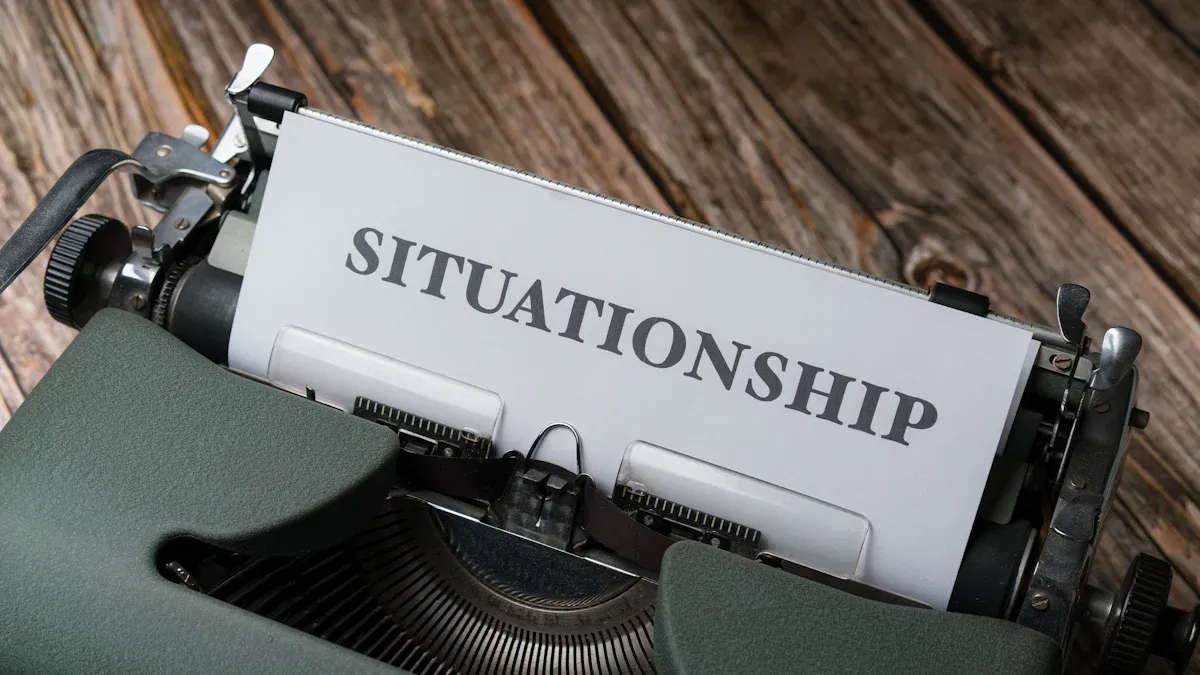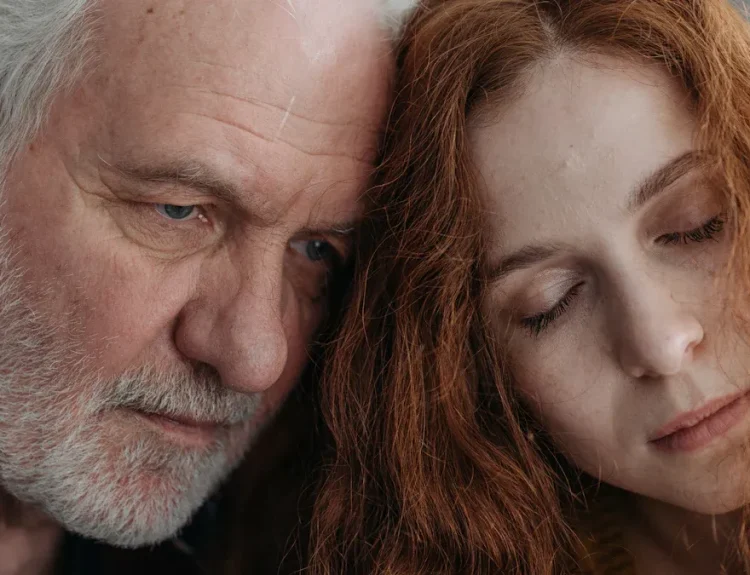A situationship is like dating but has no clear rules. You may hang out a lot and text each other often. You might feel close to the other person. But you do not talk about what you both want. A relationship has commitment and shared goals. A situationship often makes you guess what is happening. Many young adults have been in a situationship. About half of people aged 18–34 have had one. If you know the difference, you can protect your feelings. You can also make choices that are right for you.
Key Takeaways
A situationship feels like dating but has no clear promise. There are no labels or plans for the future. This can make people feel confused and worried.
Relationships have clear rules and open talking. People in relationships share goals and help each other. This makes them feel safe and trust each other.
Signs of a situationship are not having clear labels. People may not talk often or have an unsure future. The rules can change a lot.
Situationships give freedom and less stress. But they can also bring mixed feelings and mood swings.
To move forward, be honest about what you need. Talk clearly and set your own rules. Pick what makes you feel important and safe.
Definitions
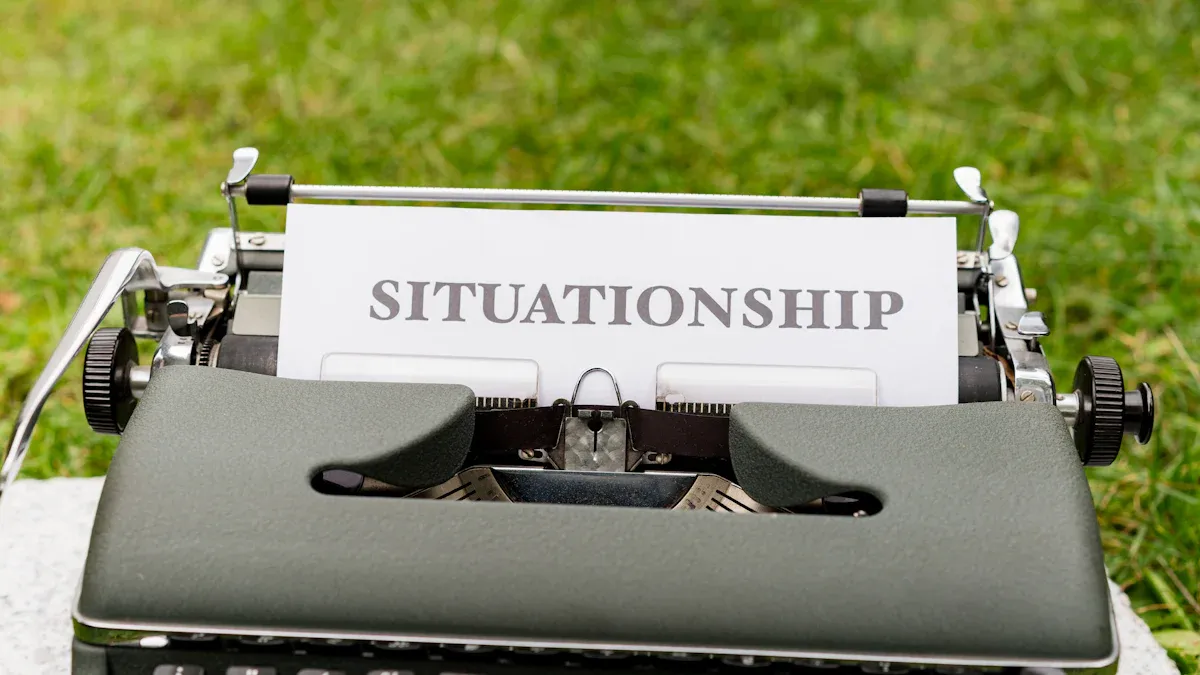
Situationship
You can be in a situationship if you feel close to someone but never talk about what you both want. This kind of connection looks like dating, but there are no clear rules or labels. Here are some signs experts use to explain a situationship:
You spend time together and act like a couple, but you do not call each other boyfriend or girlfriend.
You do not talk much about the future or make big plans.
The connection feels easy. You see each other when it fits your schedules, not because you always want to.
You might not know if you are only seeing each other. Both of you could date other people.
Your talks are usually simple. You may skip deep talks about feelings or goals.
Sometimes, you feel unsure about your place. The other person’s effort can change a lot.
A situationship gives you some good things, like company and affection, but it keeps things open and not clear. This can feel fun at first, but not knowing what is happening may leave you guessing and sometimes worried.
Relationship
A relationship gives you more safety and direction. In a committed relationship, you and your partner agree on what you want. You talk openly about your feelings, your goals, and your future together. Here is what makes a relationship different:
You both agree to be together and often choose to be exclusive.
You talk about important things, like dreams, values, and plans.
You help each other and solve problems as a team.
You know your place. Labels and rules are clear, so you feel safe and important.
Tip: If you want to know if you are in a relationship, ask yourself if you both talk about the future and share your feelings honestly.
Let’s look at the main differences in a simple table:
Aspect | Situationship | Relationship |
|---|---|---|
No clear commitment or labels | Clear commitment and agreed labels | |
Communication | Light, casual, avoids serious topics | Open, honest, talks about future and feelings |
Emotional Investment | Can be uneven or shallow | Strong, shared, and supportive |
Future Planning | Rarely discussed | Regularly discussed and planned together |
Boundaries | Unclear, often shifting | Clear and agreed upon by both partners |
The biggest difference is about commitment and being clear. In a situationship, you may feel close but still wonder what will happen next. In a relationship, you both know your place and what you want together.
Key Differences
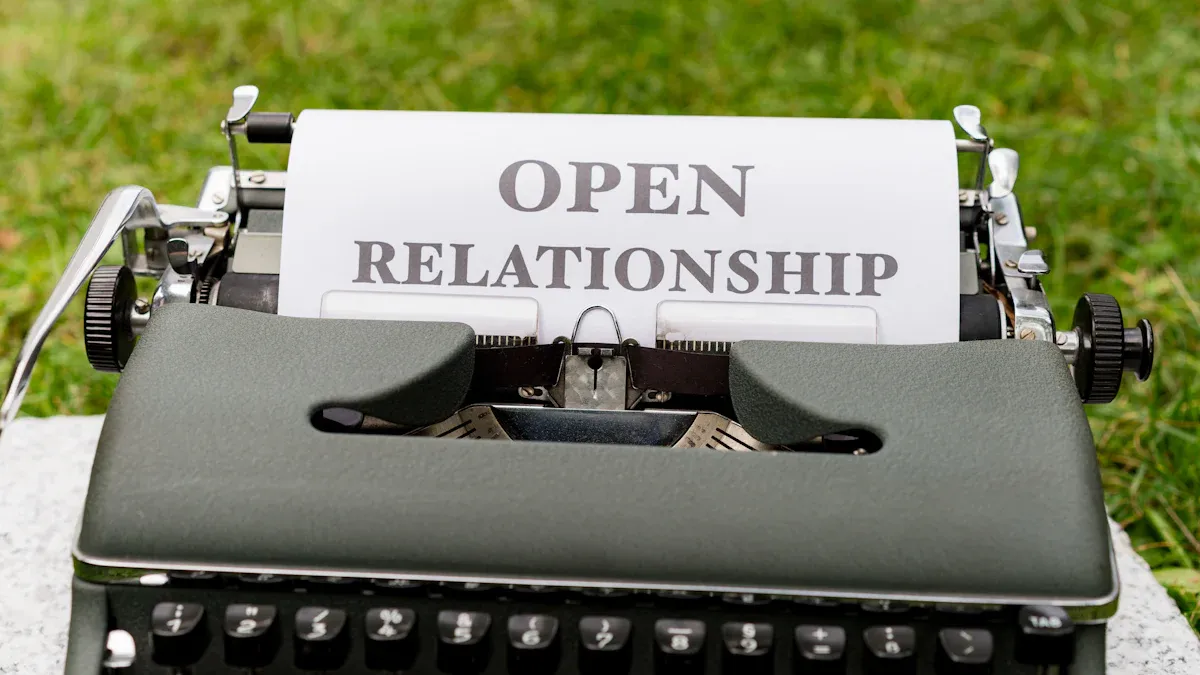
Commitment
There is a big difference in commitment between a situationship and a relationship. In a situationship, you might hang out together, but you do not make promises. You also do not set rules about being together. You may not talk about being exclusive. This can make you wonder where you stand. In a relationship, you both agree to be together. You talk about what you want and set clear boundaries.
Here is a table that shows how common situationships are, especially for younger adults:
Statistic Description | Value/Percentage | Demographic/Context |
|---|---|---|
Americans aged 18-34 who have been in a situationship | 50% | Younger adults (18-34) |
Overall US adults who have been in a situationship | 39% | All adults (18+) |
Situationships that began in person | 55% | All adults |
Situationships started through social media (18-34) | 29% | Younger adults (18-34) |
Situationships started through dating apps | 7% | All adults |
Adults aged 18-34 likely to recommend situationship apps | 63% | Younger adults (18-34) |
Men likely to recommend situationship apps | 44% | Gender comparison |
Women likely to recommend situationship apps | 35% | Gender comparison |
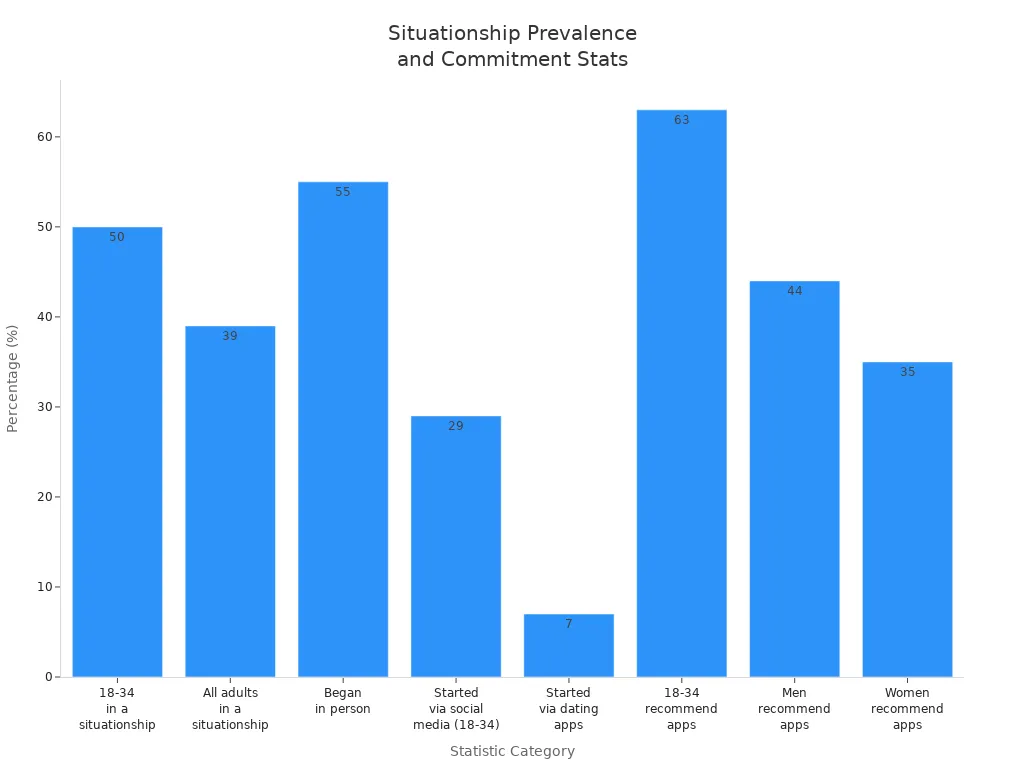
You can see that many people aged 18-34 have tried a situationship. This means commitment is often missing or not clear in these connections. Relationships are different because they focus on shared goals and clear promises.
Note: Many same-sex couples start as friends. They move through a situationship before becoming partners. This is common and shows how commitment can grow over time.
Communication
Communication is not the same in a situationship and a relationship. In a situationship, you might text or call, but there is no steady pattern. Sometimes you talk a lot. Sometimes you do not hear from each other for days. You may avoid talking about what you both want. You might not talk about where things are going. This can make you feel unsure or even worried.
Here are some ways communication changes between the two:
In a situationship, you often skip talks about commitment or the future.
You might not use labels or talk about your feelings deeply.
The connection stays light and casual, with no clear direction.
In a relationship, you talk openly and often.
You discuss your goals, feelings, and what you both expect.
You know where you stand because you both share your thoughts and plans.
When you have honest talks, you feel safer and more connected. Relationships give you this steady communication. Situationships often leave you guessing.
Emotional Investment
Some people think a situationship means you do not care much. That is not always true. Many people in situationships feel strong emotions. They spend a lot of time and energy. The problem is, the feelings are not always balanced. One person might want more. The other person keeps things casual. This can lead to hurt feelings, worry, and sadness.
People in situationships often feel emotionally and sexually invested, even without commitment.
The lack of clear rules can make you feel rejected or not good enough.
You might feel anxious because you do not know where you stand.
Some people choose situationships to avoid getting hurt, but this can backfire and cause more pain.
Relationships offer more emotional safety and support. You know your partner cares and wants to be there for you.
Tip: If you feel like you are always waiting for the other person to show they care, you might be in a situationship. Relationships should make you feel valued and secure.
Future Plans
Future plans are another big difference. In a situationship, you rarely talk about what comes next. You might avoid questions about vacations, holidays, or even next week. This keeps things open but also uncertain. You do not know if you will still be together in a month or a year.
Research shows that people in committed relationships talk about their future. They plan trips, talk about living together, or even discuss marriage and kids. These plans help you feel safe and give your connection a clear path forward.
In a situationship, you might feel stuck. You want to know what will happen, but you do not get answers. This can make you feel lost or worried about wasting your time.
Reminder: If you want a future with someone, look for signs that you both talk about plans and dreams. If those talks never happen, you might be in a situationship.
Situationship Signs
No Clear Labels
You might notice that you and the other person never talk about what you are to each other. There is no “boyfriend,” “girlfriend,” or even “partner” label. You just hang out, text, and maybe act like a couple, but you avoid the big conversation. This can make you feel confused or even anxious. Studies show that when people do not have clear labels, they often feel more pressure and worry about what others think. You may even feel less confident about yourself because you do not know where you stand.
Not having a label can make you feel left out or unsure, especially when friends ask about your status.
Uncertain Future
In a situationship, you rarely talk about the future. You might not know if you will spend holidays together or even see each other next week. Plans are often last-minute, and you do not make promises. This lack of direction can leave you feeling stuck or worried. Research shows that people feel happier and more secure when they know what to expect. If you always wonder what comes next, you are likely in a situationship.
No talks about vacations or big life events
No promises about being together long-term
You feel unsure about where things are going
Inconsistent Contact
Contact in a situationship can feel like a rollercoaster. Some days you get lots of texts or calls, and then you might not hear anything for days. Plans can change quickly, and you never know when you will see each other next. This pattern can make you question if you are asking for too much or if your feelings are one-sided.
Messages can go from daily to silence without warning
Plans are vague and often made at the last minute
Conversations stay light and avoid deep topics
If you feel confused by mixed signals, you are not alone. Many people in situationships report this same pattern.
Ambiguous Boundaries
Boundaries in a situationship are often unclear. You might not know if you can date other people or if you should expect the other person to be there for you. This can lead to mixed feelings and even emotional exhaustion. People who are sensitive to others’ feelings may feel especially drained by this uncertainty. You may find yourself overthinking every message or action, trying to figure out what is okay and what is not.
Clear boundaries help you feel safe. Without them, you may feel anxious or unsure about your place in the other person’s life.
Pros and Cons
Benefits
Situationships can offer you some real perks, especially if you want something light and flexible. Here are some reasons why people enjoy them:
You don’t have to rush into labels or big decisions. You can just enjoy the moment and see where things go.
There’s less pressure to fit into a traditional relationship mold. You get to make your own rules.
You can focus on your own goals, like school or work, without feeling tied down.
You get to know someone at your own pace. There’s no need to force things or move too fast.
You can enjoy emotional and physical closeness without the heavy responsibilities of a committed relationship.
If you’re not ready for a long-term partner, a situationship gives you freedom to explore and experiment.
You might find the excitement of not having labels keeps things fun and fresh.
Breakups feel easier because there are no official rules or big expectations.
Many people say situationships help them avoid stress and let them learn about themselves and others without pressure.
Drawbacks
Situationships also come with some downsides. You might feel confused or anxious because you never know where you stand. Sometimes, one person starts to care more than the other. When that happens, things can get messy and even painful.
You may notice that your feelings grow, but the other person doesn’t feel the same way. This can leave you feeling rejected or hurt. Studies show that people in situationships often feel less satisfied with life and more stressed, especially when you and your partner want different things. The lack of clear direction can make you question your worth or worry about wasting your time.
If you want more than just casual fun, a situationship might leave you feeling empty or regretful. The uncertainty can be exciting at first, but it often leads to confusion and emotional ups and downs.
Some people find situationships work well for them, especially if they like freedom and don’t want commitment. Others end up wishing for more clarity and support. It all depends on what you need and expect from your connections.
Moving Forward
Assess Your Needs
Before you decide what to do next, take a moment to check in with yourself. Ask yourself what you really want from this connection. Do you feel happy with things as they are, or do you wish for more clarity and commitment? Experts suggest a few ways to help you figure this out:
Be upfront about your expectations. Have the “What Are We?” talk early.
Set clear boundaries for communication, intimacy, and exclusivity.
Reflect on your needs and desires. Think about what matters most to you in a relationship.
Don’t settle for less than what matches your values. Be willing to walk away if needed.
Use self-awareness to decide if the uncertainty of a situationship fits your goals.
Remember, you deserve a connection that makes you feel safe and valued.
Communicate Clearly
If you want things to change, you need to speak up. Clear communication is the key to moving from a situationship to a real relationship. Studies show that honest talks about feelings and expectations often help couples grow closer. Here’s how you can do it:
Reflect on your feelings and decide what you want.
Choose a good time to talk—no distractions.
Use “I” statements to share your thoughts without blaming.
Listen to your partner’s side and respect their feelings.
Set clear boundaries and talk about what you both want.
When you talk openly, you avoid misunderstandings and protect your heart. If you stay silent, things may never change.
Decide Next Steps
Now it’s time to act. Relationship coaches say the most successful steps include:
Set clear boundaries and agree on the type of relationship you want.
Respect each other’s needs and talk about your feelings.
Replace casual hangouts with real dates and deeper conversations.
Spend more time together in person, not just texting.
Introduce your partner to your friends and family if you want more commitment.
Make the relationship exclusive if you both agree.
Know your worth. If your partner won’t commit, be ready to move on.
Trust yourself. You have the right to choose what feels best for you and your future.
You now know the big differences between a situationship and a real relationship. Think about what you want and how you feel. Experts say you should set clear boundaries, care for yourself, and talk openly about your needs. If you decide to move on, be honest and kind. Remember, you deserve trust, safety, and happiness in any connection. 🌱
FAQ
What if you want a relationship but your partner prefers a situationship?
You should talk about your feelings. Let your partner know what you want. If you both want different things, it may be time to move on. You deserve someone who shares your goals.
Can a situationship turn into a real relationship?
Yes, it can! Sometimes people start casual and grow closer over time. Honest talks and shared goals help. If you both want more, you can move forward together.
How do you end a situationship without drama?
Be honest and kind. Tell the other person how you feel. Use “I” statements. Thank them for the good times. You can walk away with respect for both of you.
Is it okay to enjoy a situationship?
Absolutely! If you feel happy and safe, a situationship can work for you. Just check in with yourself often. Make sure your needs get met and you feel good about your choice.

